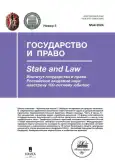International legal protection of cultural heritage during armed conflicts: History of formation and modern mechanisms (To the 70th anniversary of the 1954 convention for the protection of cultural property in the event of armed conflict)
- Authors: Abdullin A.I.1, Gibadullin T.D.1
-
Affiliations:
- Kazan Federal University
- Issue: No 5 (2024)
- Pages: 142-152
- Section: Law and international relations
- URL: https://vestnik.nvsu.ru/1026-9452/article/view/648950
- DOI: https://doi.org/10.31857/S1026945224050153
- ID: 648950
Cite item
Abstract
The article is devoted to the study of topical problems of the history of the formation of international legal mechanisms in the field of protection of cultural heritage in the event of armed conflict and of modern measures in this area. The authors consistently analyze the relevant norms of both general and special nature of all major international legal acts relating to these issues, starting with the 1874 Brussels Declaration concerning the Laws and Customs of War as the earliest relevant document. The issue of the relationship between the 1954 Convention for the Protection of Cultural Property in the Event of Armed Conflict and the 1977 Additional Protocols to the 1949 Geneva Conventions is considered. A conclusion is drawn about the subsidiary nature of the special norms of the 1977 Additional Protocols in relation to the norms of the 1954 Convention. The resulting coincidence of the scope of the definition of cultural property for the purposes of the 1954 Convention and its Protocols, on the one hand, and of the corresponding special rules of the 1977 Additional Protocols, on the other, is substantiated. The shortcomings of the individual international legal acts mentioned are indicated, including those related to the virtually non-functioning “special protection” regime enshrined in the 1954 Convention. The lack of norms directly protecting intangible cultural heritage is discussed as a shortcoming of the entire array of international legal norms in the field of protection of cultural heritage in the event of armed conflict.
Full Text
About the authors
Adel I. Abdullin
Kazan Federal University
Author for correspondence.
Email: adelabdoulline@yandex.ru
Doctor of Law, Professor, Head of the Department of International and European Law
Russian Federation, KazanTimur D. Gibadullin
Kazan Federal University
Email: timurgib@gmail.com
PhD in Law, Assistant of the Department of International and European Law
Russian Federation, KazanReferences
- Pustogarov V. V. F. F. Martens: lawyer, diplomat, publicist // Soviet Journal of International Law. 1991. No. 3–4. Pp. 86, 91 (in Russ.).
- Blake J. On Defining the Cultural Heritage // The International and Comparative Law Quarterly. 2000. Vol. 49. No. 1. P. 67.
- Forrest C. International Law and the Protection of Cultural Heritage. London; New York, 2010. P. 24.
- Francioni F. Cultural Heritage // Max Plank Encyclopedia of Public International Law [Electronic resource]. URL: https://opil.ouplaw.com/view/10.1093/law: epil/9780199231690/law-9780199231690-e1392?prd=MPIL (accessed: 25.02.2024). Para. 1, 4, 6–8.
- Frigo M. Cultural property v. cultural heritage: A “battle of concepts” in International Law? // International Review of the Red Cross. 2004. Vol. 86. No. 854. P. 367.
- International List of Cultural Property under Enhanced Protection [Electronic resource]. URL: https://en.unesco.org/sites/default/files/enhanced-protection-list-2022_eng_3.pdf (accessed: 18.07.2023).
- Merryman J. H. Two Ways of Thinking About Cultural Property // The American Journal of International Law. 1986. Vol. 80. No. 4. P. 837.
- Nafziger J. A.R. Frontiers of Cultural Heritage Law. Leiden; Boston, 2021. P. 8, 13.
- Nafziger J. A.R., Paterson R. K., Renteln A. D. Cultural Law: International, Comparative, and Indigenous. Cambridge, 2010. P. 289.
- Odendahl K. Global conventions for the protection of cultural heritage // Cultural Heritage and Legal Aspects in Europe / ed. by M. Guštin, T. Nypan. Koper: Institute for Mediterranean Heritage, Institute for Corporation and Public Law, Science and Research Centre, University of Primorska, 2010. P. 102, 106, 107, 113.
- O’Keefe R. Cultural Heritage and International Humanitarian Law // The Oxford Handbook of International Cultural Heritage Law / ed. by A. F. Vrdoljak, F. Francioni. Oxford, 2020. Pp. 44, 46–52.
- Prott L. V., O’Keefe P.J. ‘Cultural Heritage’ or ‘Cultural Property’? // International Journal of Cultural Property. 1992. Vol. 1. No. 2. P. 307, 312.
- Rules of Air Warfare (19 February 1923) // American Journal of International Law. 1923. Vol. 17. Supplement. P. 246.
- Stamatoudi I. A. Cultural Property Law and Restitution: A Commentary to International Conventions and European Union Law. Cheltenham, UK; Northampton, MA, USA, 2011. P. 7.
- Treaty on the Protection of Artistic and Scientific Institutions and Historic Monuments (Roerich Pact) (15 April 1935) // The Laws of Armed Conflicts: A Collection of Conventions, Resolutions and Other Documents / ed. by D. Schindler, J. Toman. 3rd ed. Dordrecht, 1988. Pp. 737–739.
- Treaty on the Protection of Artistic and Scientific Institutions and Historic Monuments (Roerich Pact). Washington, 15 April 1935. State parties [Electronic resource]. URL: https://ihl-databases.icrc.org/applic/ihl/ihl.nsf/States.xsp?xp_viewStates=XPages_NORMStatesParties&xp_treatySelected=325 (accessed: 22.02.2024).
- Vrdoljak A. F., Francioni F. Introduction // The Oxford Handbook of International Cultural Heritage Law / ed. by A. F. Vrdoljak, F. Francioni. Oxford, 2020. P. 4.
- Vrdoljak A. F., Meskell L. Intellectual Cooperation Organisation, UNESCO, and the Culture Conventions // The Oxford Handbook of International Cultural Heritage Law / ed. by F. Francioni, A. F. Vrdoljak. Oxford, 2020. P. 27, 28.
Supplementary files








